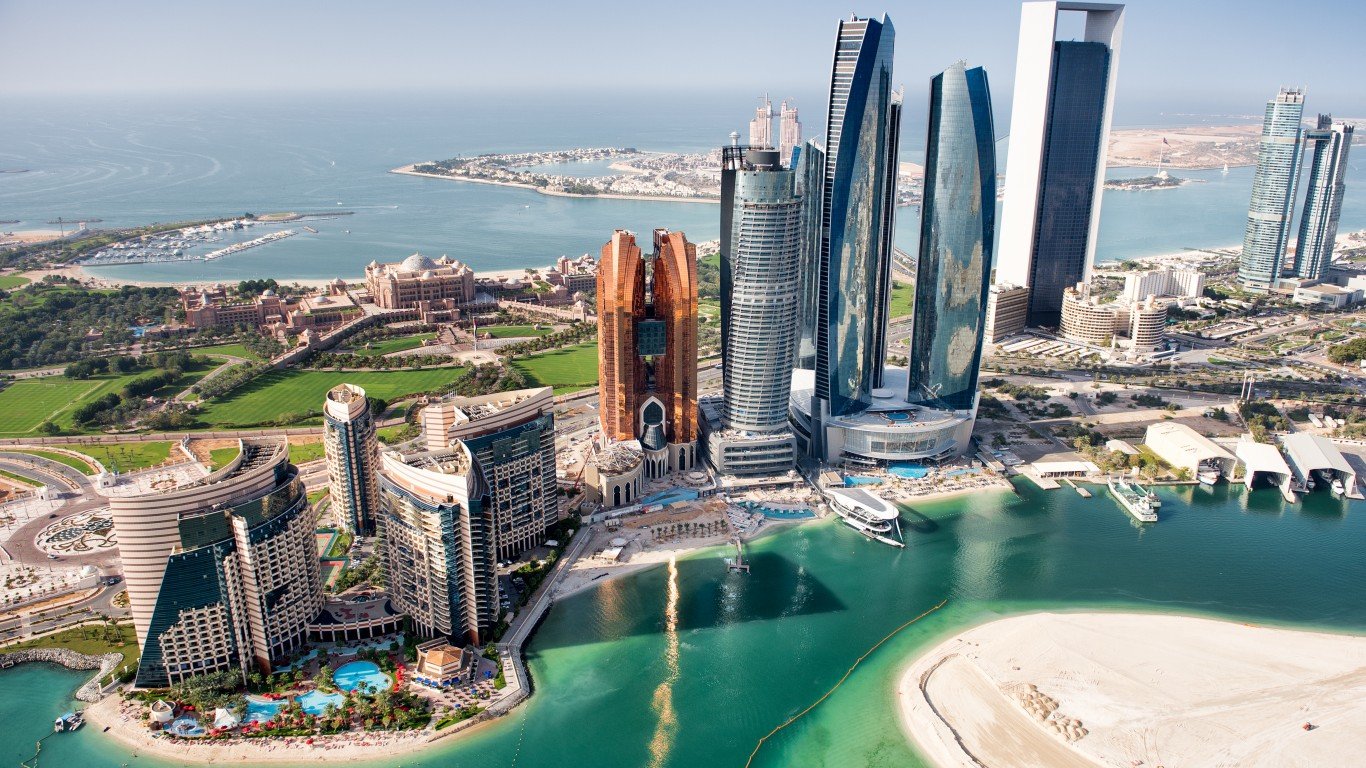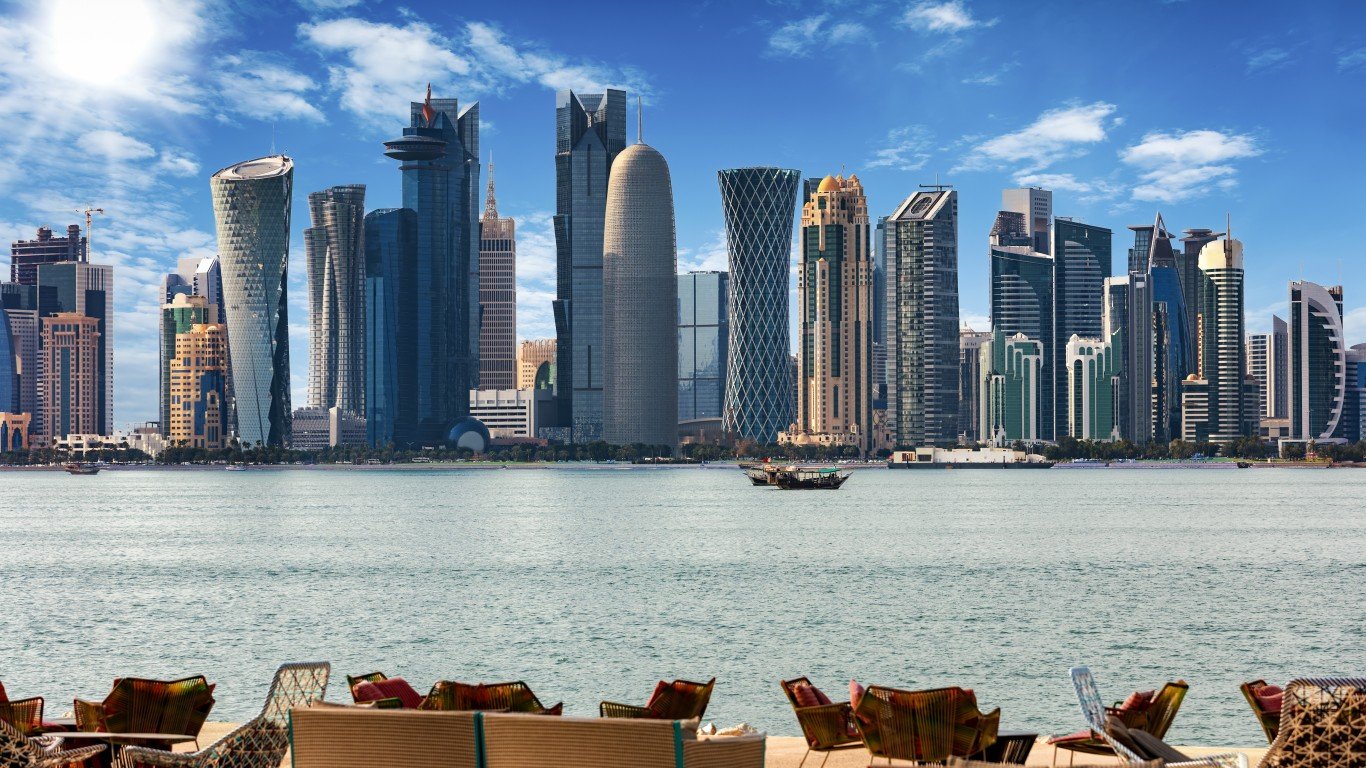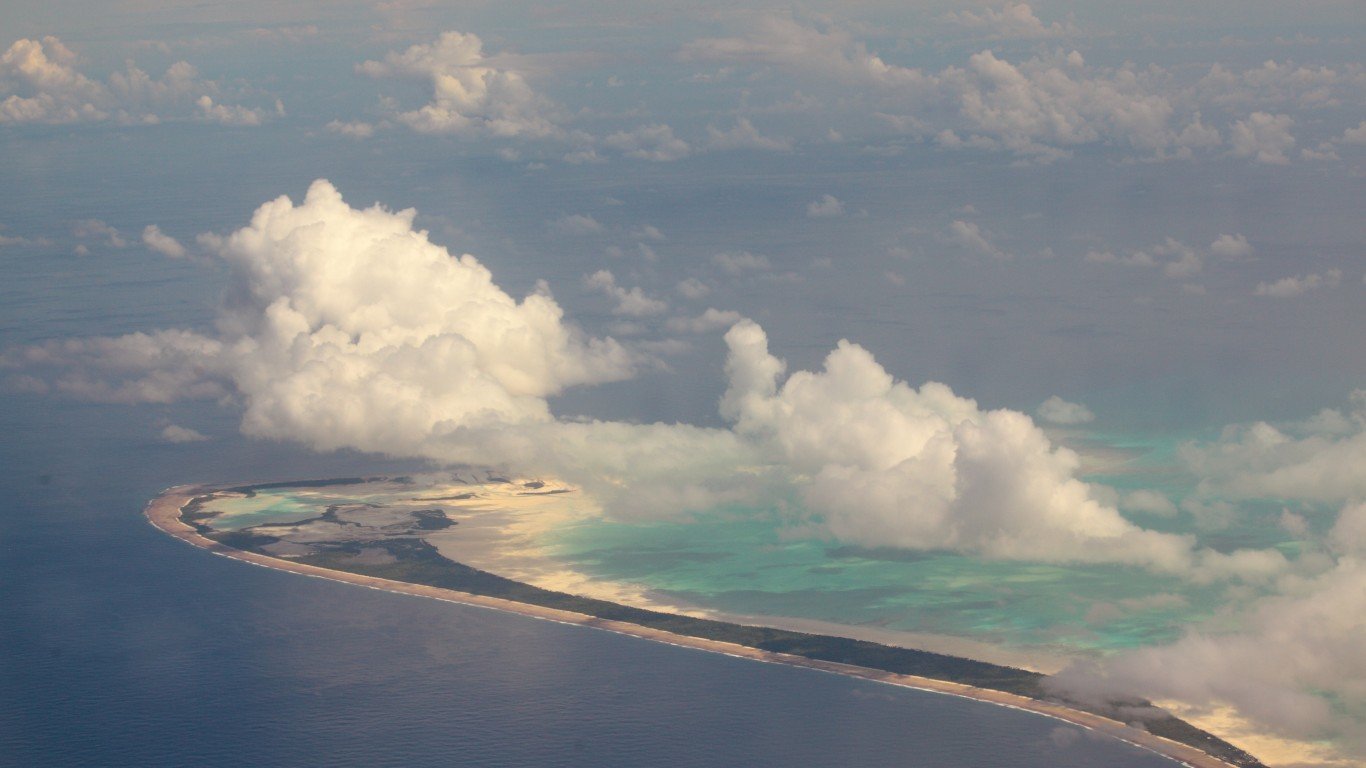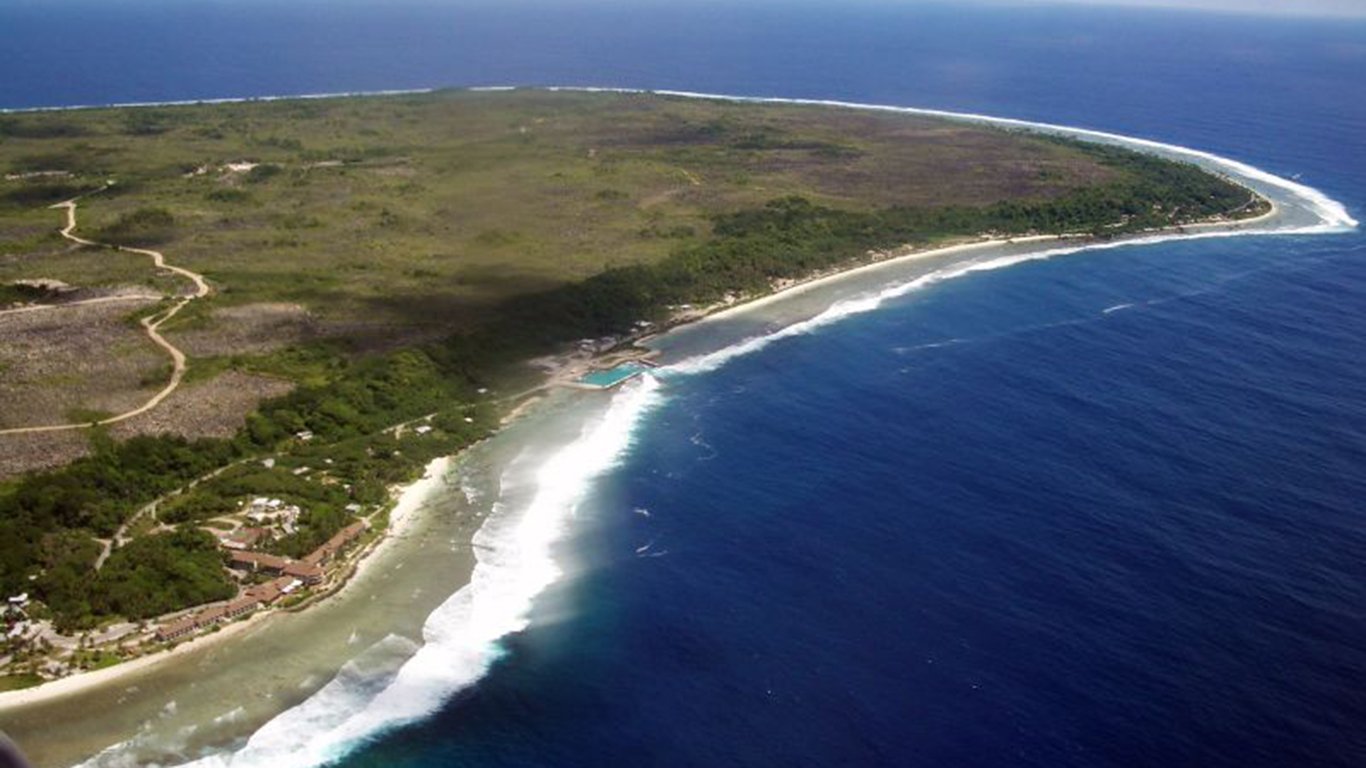The World’s Most Overweight Countries
July 11, 2018 by Cheyenne BuckinghamThe prevalence of adults who are overweight or obese is on the rise — global obesity has nearly tripled since 1975. Close to 2 billion adults worldwide, or 39% of the global adult population, were considered overweight in 2016. In some of the most overweight countries, the percentage is at least double that. Of these near 2 billion overweight adults worldwide, 650 million or 13% of adults, were classified as obese.
A body mass index score, or BMI, is defined as a person’s weight in kilograms divided by the their height in meters squared.The World Health Organization defines being overweight as having a body mass index of 25 or greater. Obesity is defined as a BMI of 30 or greater.
24/7 Wall St. reviewed World Health Organization 2016 BMI data for adults in 195 countries. In the 20 most overweight countries, at least 66% of adults have a BMI of 25 or greater.
The 20 countries with the largest percentages of adults who are overweight are located almost entirely in two regions of the world: the Middle East and Oceania. Seven countries in the lower half of the most overweight nations are located in the Middle East. All 10 of the nations where the largest share of adults are overweight are Oceanic countries.
Click here to see the world’s most overweight countries.
Click here to read our detailed finding and methodology.

20. Malta
> Percent overweight, 2016: 66.4%
> Percent overweight, 2006: 62.8%
> GDP per capita: $35,058
> Region: Europe
Some 66.4% of adults 18 and over in Malta are overweight — defined as having a body mass index of 25 or greater. The European Union’s smallest member state is located about 60 miles south of Sicily. Not only are Malta’s adults more likely to be overweight than the residents of most countries, a study from last year found that 40% of Maltese children were either overweight or obese. The nation’s struggles with weight encouraged Maltese experts to work in collaboration with other member states to develop and implement guidelines to improve the standards of food served in schools. These guidelines include requiring more nutritious meals served as lunches for children at school.
[in-text-ad]

19. Turkey
> Percent overweight, 2016: 66.8%
> Percent overweight, 2006: 60.5%
> GDP per capita: $14,298
> Region: West & Central Asia
Turkey is one of seven Middle Eastern nations on this list of 20 countries where the highest share of adults are overweight. Some 66.8% of adults in Turkey are overweight, one of the highest percentages of any country. And the rate at which adults are becoming overweight is increasing. In just 10 years, the prevalence of adults with a body mass index of 25 or more increased by 6.3 percentage points, tied with the United Arab Emirates for the largest increase of any country on this list.

18. Libya
> Percent overweight, 2016: 66.8%
> Percent overweight, 2006: 61.1%
> GDP per capita: $23,756
> Region: North Africa
At least 60% of adults in every nation in North Africa are overweight, but Libya has the highest share in the region, at 66.8% of the adult population. There is a substantial gender difference in weight in Libya, as 63.4% of men have a body mass index of at least 25, compared to 70% of women. The health-threatening condition has become much more prevalent in Libya in the past decade. In 2006, 56.9% of men and 65.6% of women were overweight.

17. United Arab Emirates
> Percent overweight, 2016: 67.8%
> Percent overweight, 2006: 61.5%
> GDP per capita: $67,706
> Region: West & Central Asia
The United Arab Emirates is one of the wealthiest nations on earth, as its nearly world-leading oil reserves have led to substantial economic growth over the past few decades. With that wealth, it appears the nation’s residents have adopted sedentary lifestyles and overeating habits that are more common in affluent countries. The share of adults who are overweight has risen from 61.5% in 2006 to 67.8% in 2016, a 6.3 percentage point increase — and residents are already facing some alarming health effects. An estimated 19% of the country’s adult population has been diagnosed with diabetes.
[in-text-ad-2]

16. United States
> Percent overweight, 2016: 67.9%
> Percent overweight, 2006: 62.5%
> GDP per capita: $13,268
> Region: North America
Nearly 68% of adults in the United States have a BMI of 25 or greater, the highest share in North America, with Mexico at 64.9%. The United States also has an overwhelming share of obese adults. According to the Centers for Disease Control and Prevention, 39.8% of U.S. adults are obese, meaning they have a BMI of 30 or greater.
The disparity between overweight American men and women is stark. In 2016, 72.7% of males were overweight compared to 63.2% of females. Both of these figures have grown considerably since 2006, when 67.6% of males and 57.6% of females were overweight.

15. Lebanon
> Percent overweight, 2016: 67.9%
> Percent overweight, 2006: 62.9%
> GDP per capita: $53,399
> Region: West & Central Asia
Lebanon is one of seven Middle Eastern countries among the 20 most overweight nations, with 67.9% of its adult population having a BMI of 25 or greater. Weight is a serious issue in Lebanon and can cause a variety of other health complications and chronic diseases. Some 17.9% of Lebanese adults have a higher likelihood of dying from cardiovascular disease, cancer, diabetes, or chronic respiratory disease — more than many countries in the Middle East.
[in-text-ad]

14. Jordan
> Percent overweight, 2016: 69.6%
> Percent overweight, 2006: 64.2%
> GDP per capita: $8,390
> Region: West & Central Asia
Jordan is one of seven countries in the Middle East that are among the 20 most overweight nations in the world. The adoption of a westernized lifestyle may be a key factor in Jordan adults becoming overweight. According to a study, high-fat diets and sedentary lifestyles are becoming more prevalent, especially among women in Jordan. In 2016, 72.2% of women reported BMIs of 25 or greater, compared to 67.0% of men. And the prevalence of adults reporting high body body mass index is on the rise. A decade ago, 68.1% of women and 60.4% of males were overweight.

13. Saudi Arabia
> Percent overweight, 2016: 69.7%
> Percent overweight, 2006: 64.1%
> GDP per capita: $50,423
> Region: West & Central Asia
One of many wealthy nations in the Middle East struggling with a growing overweight and obese adult population, almost 70% of Saudi Arabia’s adults have a body mass index of at least 25. And like many of its neighbors, conditions have worsened a great deal in the last decade. The share of adults who are overweight has increased by 5.6 percentage points since 2006.

12. Qatar
> Percent overweight, 2016: 71.7%
> Percent overweight, 2006: 66.1%
> GDP per capita: $118,207
> Region: West & Central Asia
Over 71% of adults in Qatar are overweight. Affluent countries tend to report higher rates of overweight or obese adults, and Qatar is the richest country in the world with a GDP of $118,207 per capita. Qatar has accumulated its wealth rapidly since 1971, when it was discovered that the nation was home to the world’s largest gas field. As an affluent nation, many adults in Qatar likely have access to healthy food and recreation facilities, but they do not appear to be taking advantage of these opportunities. According to one study, 45% of the adult population eats fast food more than three times a week, and 83% engage in little to no exercise.
[in-text-ad-2]

11. Kuwait
> Percent overweight, 2016: 73.4%
> Percent overweight, 2006: 69.0%
> GDP per capita: $68,862
> Region: West & Central Asia
Several nations within the Middle East are among the wealthiest nations in the world, and Kuwait is one of them. The Persian Gulf nation is one of the wealthiest countries in the world. Countries with greater wealth tend to report a higher prevalence of overweight adults. Nearly three-quarters of Kuwait’s adult population is overweight with 73.4% reporting BMIs of 25 or greater. Kuwait is one of seven Middle Eastern countries to rank among the 20 most overweight nations.

10. Micronesia
> Percent overweight, 2016: 75.9%
> Percent overweight, 2006: 70.5%
> GDP per capita: $3,253
> Region: Oceania
Nearly 76% of Micronesia’s adult population is overweight. While the bottom half of world’s 20 most overweight countries are relatively affluent, the top half are quite the opposite. The top 10 nations reporting the highest shares of adults with BMI scores of 25 and over are all located in the Oceania region.
Carrying excess weight can lead to several life-threatening health conditions and chronic diseases. In Micronesia, 26.1% of adults are likely to die between the ages of 30 and 70 from cancer, diabetes, or chronic respiratory disease, one of the highest percentages of all nations in the Oceanic region.
[in-text-ad]

9. Samoa
> Percent overweight, 2016: 77.6%
> Percent overweight, 2006: 73.1%
> GDP per capita: $5,914
> Region: Oceania
Some 77.6% of adults in Samoa are overweight. The island nation Samoa is one of the 10 most overweight countries in the world, which all happen to be centralized in Oceanic region. While the adoption of a westernized lifestyle — consuming high-calorie, processed foods and minimal exercise — is partially to blame, there is another factor that may be inhibiting Samoan adults’ ability to maintain a healthy weight.
Researchers have discovered a gene that increases a person’s obesity risk by 40% and this gene is present in 25% of all Samoans. The gene is unique to Samoans because it developed likely over 3,000 years ago when the Samoans were colonizing the South Pacific Islands. The gene enables Samoans to store more fat and release less energy, which enabled them to endure long voyages between islands. Today, that kind of energy is not needed for survival, which may be a major reason Samoans are reporting such high BMI scores.

8. Tonga
> Percent overweight, 2016: 78.5%
> Percent overweight, 2006: 73.6%
> GDP per capita: $5,327
> Region: Oceania
Some 78.5% of adults are overweight in Tonga. In 2004, Tonga instituted a comprehensive health strategy to combat obesity — the first Pacific Island nation to do so. However, just one year later, Tonga joined the World Trade Organization, a move that reduced import tariffs. Ever since then, families have moved farther away from their traditional healthy diet full of fruits, vegetables and fish and acquired a taste for cheap fatty meats and packaged goods. Compared to 2006, two years after Tonga became a part of the WTO, the prevalence of overweight adults in 2016 has increased by nearly 5 percentage points.

7. Kiribati
> Percent overweight, 2016: 78.7%
> Percent overweight, 2006: 74.3%
> GDP per capita: $1,955
> Region: Oceania
Kiribati is one of 10 Oceanic nations in the top 20 most overweight countries, with 78.7% of the adult population reporting BMI scores of 25 or greater. Eating a diet full of processed foods and leading a sedentary lifestyle overtime can cause obesity, which can then lead to handful of unhealthy and even deadly conditions and diseases. Some 28.4% of Kiribati adults are likely to die of cardiovascular disease, cancer, diabetes, or chronic respiratory disease between the ages of 30 and 70, one of the highest percentages of any country in the world.
[in-text-ad-2]

6. Niue
> Percent overweight, 2016: 80.0%
> Percent overweight, 2006: 74.2%
> GDP per capita: $00
> Region: Oceania
Niue, a small island country in the South Pacific ocean, is one of the most overweight nations in the world with 80% of adults having BMIs of 25 or higher. There is a considerable difference in the shares of overweight women and men. In 2016, 82.5% of women and 77.6% of men were overweight respectively. The health-threatening condition has become even more prevalent in Niue in the past decade. In 2006, 77.5% of women were overweight and 71.0% of men were overweight.

5. Tuvalu
> Percent overweight, 2016: 81.9%
> Percent overweight, 2006: 76.4%
> GDP per capita: $3,492
> Region: Oceania
Some 81.9% of adults in Tuvalu are overweight or obese. Like most of the islands in the Oceania region, there has been an ever-increasing reliance on imported foods, most of which are heavily processed packaged goods, full of sugar and saturated fat. And the prevalence of adults reporting high body body mass index is on the rise, having increased by 5.5 percentage points in the past decade.
[in-text-ad]

4. Marshall Islands
> Percent overweight, 2016: 83.5%
> Percent overweight, 2006: 79.9%
> GDP per capita: $3,730
> Region: Oceania
Some 83.5% of Marshall Islands adults are overweight, likely due in part to the island’s reliance on imported goods. Soil conditions on the islands makes growing grow rice or wheat or raising cattle extremely challenging, so all of those products are imported. This makes fresh, healthy foods often prohibitively expensive for residents. The island also imports processed foods, which tend to be less expensive and therefore make up the diets of many Marshall Islanders. Consuming a diet high in carbohydrates, sugar, and fat can lead to many health complications, including diabetes. Diabetes has plagued many native to the Marshall Islands. The International Diabetes Federation says that more than one-third of the population has diabetes, one of the highest rates in the world.

3. Cook Islands
> Percent overweight, 2016: 84.7%
> Percent overweight, 2006: 80.9%
> GDP per capita: $00
> Region: Oceania
The Cook Islands is one of the most overweight nations in the world. A reported 84.7% of adults in this country are overweight, up from 80.9% in 2006. The collection of islands located in the Oceania region of the Pacific are more prone to having a higher body mass because they depend on imported goods, most of which are heavily processed. Issues with weight start at a young age in the Cook Islands as 27% of kids ages five to 19 are overweight. Even more concerning is the 35% of teens ages 13 to 18 who are obese.

2. Palau
> Percent overweight, 2016: 85.1%
> Percent overweight, 2006: 80.9%
> GDP per capita: $13,897
> Region: Oceania
Palau has the second highest percentage of overweight adults in the world, at 85.1%. Even more concerning is the 45.1% of the adult population that is obese. For perspective, 39.8% of adults in the United States are obese. Since Palau is an island, it relies heavily on imported food, which means healthier options are that much more expensive. A cheaper alternative is fast food, which likely contributes to Palau adults’ high body mass index and the development of Type II diabetes. According to the World Bank, over one in five adults in Palau have diabetes.
[in-text-ad-2]

1. Nauru
> Percent overweight, 2016: 88.5%
> Percent overweight, 2006: 86.5%
> GDP per capita: $12,951
> Region: Oceania
Nauru, an island that’s only 8.1 square miles and home to 10,000 people, is the most overweight nation in the world. The typical Nauru diet consists of white rice, instant noodles, pop, and other processed goods. The island’s health authorities efforts to achieve better health have been held back due to the nation’s economic downturn. A majority of Nauru’s food is imported, which makes it expensive — particularly the healthier options — and harder for the general public to access.
Detailed Findings and Methodology
With the exception of Lebanon and Jordan, the most overweight Middle Eastern nations have among the highest GDPs per capita in the world. Middle Eastern countries have accumulated great wealth over the past decades due primarily to oil and gas production. Qatar and Kuwait, two of the wealthiest countries in the world by GDP per capita, are among the seven. Qatar is home to the world’s largest natural gas field. Kuwait is one of the world’s largest oil suppliers.
Affluent countries tend to report higher rates of overweight and obese adults, likely because they are not taking advantage of access to healthy foods and recreational facilities. Adoption of the westernized diet, which predominantly comprises heavily processed and packaged foods, genetics, and leading a sedentary lifestyle are likely large contributors to the increasing prevalence of overweight adults in the Middle East.
The United Arab Emirates and Turkey, in particular, have seen considerable jumps in the percentage of overweight adults in the past decade. The prevalence of overweight adults increased by 6.3 percentage points in both Middle Eastern countries. In the U.S., the share of adults who are overweight increased by 5.4 percentage points.
Unlike the lower half of the 20 most overweight countries, the top 10 are far from affluent and are all located in the Oceania region of the world. All are island nations, meaning they rely heavily on imported food. The diet in the islands used to consist of fish, fresh fruit, and root vegetables. But with the advent of global trade, imported food became much cheaper compared to the islanders’ staples. Those imported foods, however, tend to be calorie-rich, processed goods, often devoid of much nutritional value.
In addition, much of the land on the islands is not suitable farming. For example, though the Marshall Islands may have an abundance of fruit trees, it isn’t well suited for agriculture. Farming is a challenge because the soil contains sand and lacks organic content necessary for cultivating crops. In other islands, mining left the land also less suited for farming.
Genetics is also believed to play a role in the prevalence of obesity in the Oceanic islands. One study in particular focused on a gene found in one-quarter of all Samoans that elevates their risk of obesity by as much as 40%. The gene is said to have developed during the colonization period, when Samoans were enduring long voyages between islands. The gene enables Samoans to store more fat and release less energy. Today, Samoans do not exert that kind of energy, which likely contributes to the nation’s high prevalence of overweight adults.
To identify the world’s most overweight countries, 24/7 Wall St. tracked the age-standardized percentage of the population that have a body mass index (BMI) greater than or equal to 25, which was provided by the WHO, and is for 2016. Per-capita GDP figures came from the World Bank’s World Development Indicators and are for 2016. Region classifications were retrieved from the International Union for Conservation of Nature.
Sponsored: Attention Savvy Investors: Speak to 3 Financial Experts – FREE
Ever wanted an extra set of eyes on an investment you’re considering? Now you can speak with up to 3 financial experts in your area for FREE. By simply
clicking here you can begin to match with financial professionals who can help guide you through the financial decisions you’re making. And the best part? The first conversation with them is free.
Click here to match with up to 3 financial pros who would be excited to help you make financial decisions.